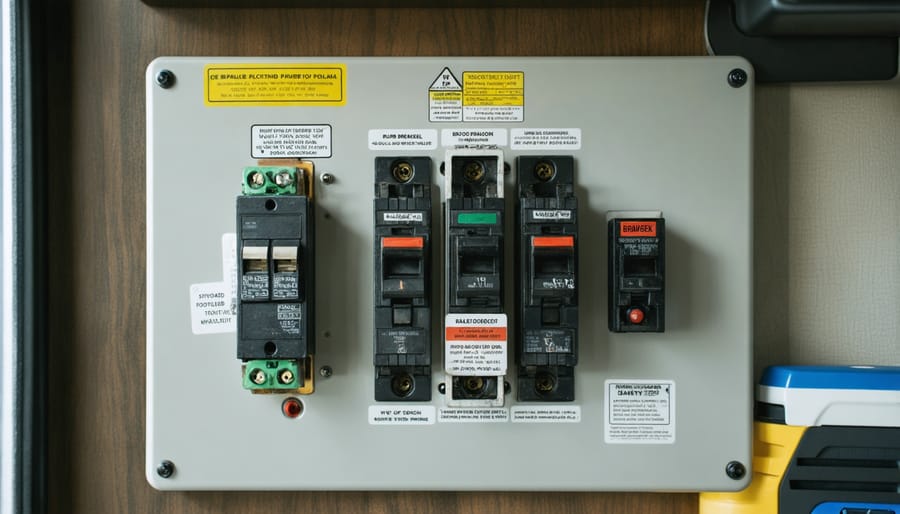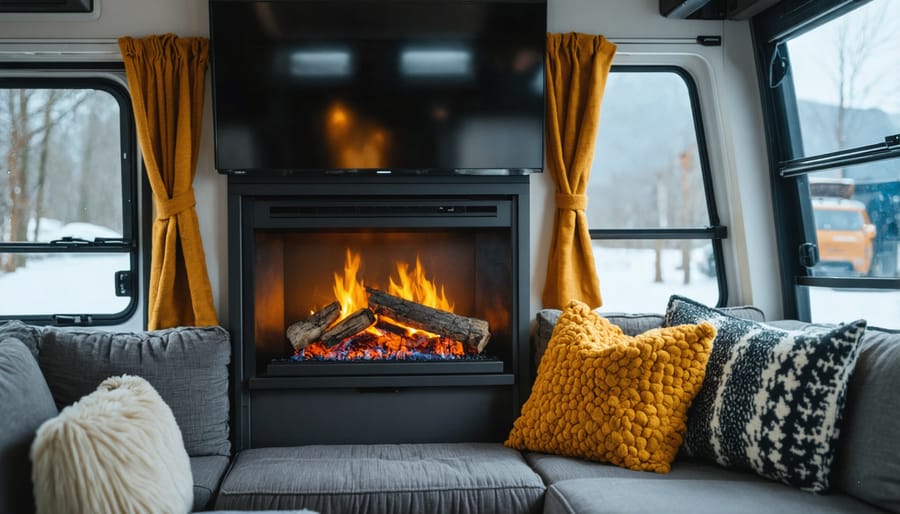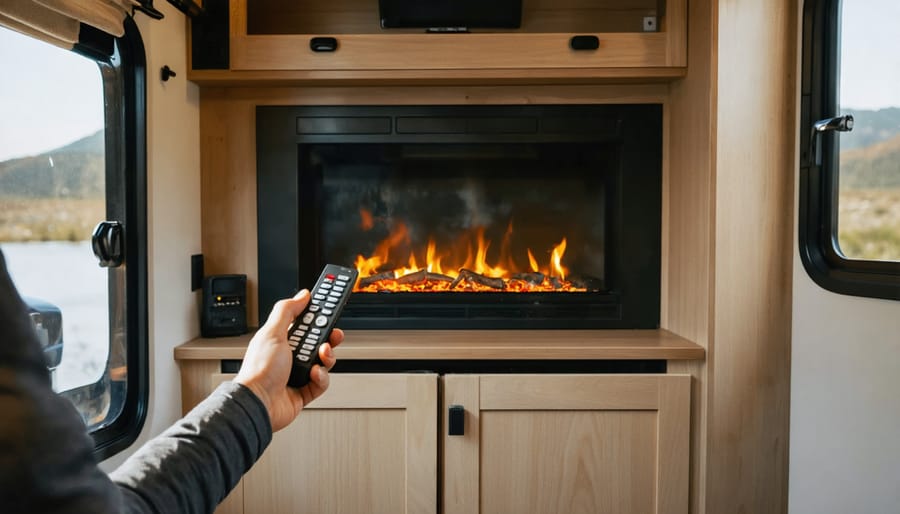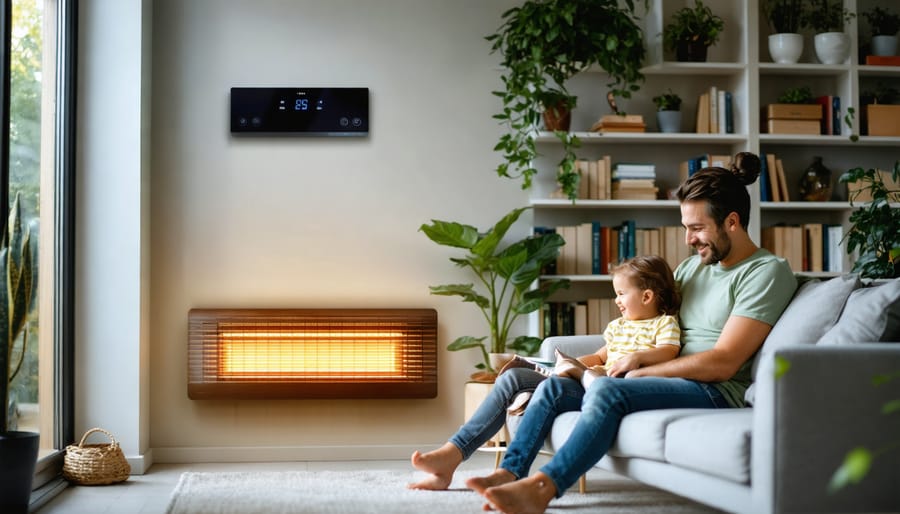Check your circuit breaker first—RV electrical systems are sensitive to power draws, and electric fireplaces often trip breakers when competing with other appliances. Reset the breaker, then test your fireplace alone before adding other devices to the circuit. Inspect the power cord and outlet connection for looseness caused by road vibration, as RV travel constantly jostles electrical connections that would remain stable in traditional homes.
Verify your remote control batteries haven’t died and that the manual control panel responds—many RV owners troubleshoot the entire unit before realizing it’s simply a dead battery issue. Test the thermostat setting by turning it significantly higher than the current temperature; RV thermostats can be affected by placement near windows or vents, creating false temperature readings that prevent the fireplace from activating.
Examine whether your fireplace’s safety sensors have been triggered. Overheating sensors and tip-over switches are more sensitive in RVs due to uneven terrain and temperature fluctuations. Allow the unit to cool completely for 30 minutes, ensure it’s on level ground, and restart.
Most electric fireplace issues in RVs stem from power supply challenges rather than mechanical failures. The compact, mobile environment creates unique obstacles, but also means solutions are often simpler than you’d expect. This guide walks you through road-tested troubleshooting steps that work whether you’re parked at a campground or dry camping off-grid.
Why RV Electric Fireplaces Fail More Often Than Home Models
Your RV electric fireplace lives a much tougher life than its stationary cousins back home. While a residential fireplace sits peacefully in one spot, your RV unit bounces down highways, endures desert heat and mountain cold, and connects to wildly different power sources at each campground stop. Understanding these unique challenges helps explain why troubleshooting an RV fireplace requires a different mindset.
**Constant Vibration Takes Its Toll**
Every mile you travel shakes internal connections loose. Wire terminals that were snug at the factory gradually work themselves free. Heating elements shift position, and control boards experience micro-movements that residential units never face. Think of it like the difference between a stationary computer and a laptop—the mobile version needs sturdier internal components, yet RV fireplaces often use similar parts to home models.
**Power Supply Inconsistencies**
Campground electrical hookups vary dramatically in quality. One site might deliver a steady 120 volts, while the next fluctuates between 105 and 125 volts as neighboring RVs turn air conditioners on and off. These voltage swings stress electronic components designed for stable home power. Low voltage forces the fireplace to work harder, potentially overheating circuits, while voltage spikes can damage delicate control boards.
**Compact Wiring and Space Constraints**
RV manufacturers pack multiple systems into tight spaces, often routing fireplace wiring alongside other electrical components. This creates potential for interference and limits cooling airflow around the unit. Temperature extremes compound these issues—your fireplace might sit unused in 100-degree storage during summer, then suddenly fire up in freezing winter conditions, expanding and contracting materials in ways residential units rarely experience.
Start With the Power Source (Most Common Culprit)
Check Your Shore Power and Circuit Breakers
Your RV electric fireplace relies on a steady flow of shore power to create that cozy ambiance you love, so let’s start by checking the foundation of your electrical system.
Begin at the campground pedestal. Make sure your shore power cord is firmly connected—vibration from travel can loosen connections more than you’d think. Inspect the cord itself for any damage, fraying, or burn marks that might indicate a problem. If everything looks good there, it’s time to head inside.
Locate your RV’s main electrical panel, typically found in a bedroom closet or near the entrance. Look for any tripped breakers—they’ll be in a middle position or flipped to “off.” RV circuit breakers are sensitive by design to protect your electrical system in tight quarters. Reset any tripped breakers by switching them fully off, then back on.
Here’s where it gets interesting: low voltage is the silent troublemaker in many campgrounds, especially during peak season when everyone’s running their air conditioners. Your fireplace needs adequate voltage to operate properly—typically around 110-120 volts. If your lights are dimming or other appliances are sluggish, you’re likely dealing with low voltage.
Consider investing in a simple voltage meter (available at any hardware store) to test your power supply. Consistent readings below 105 volts mean your fireplace might not function reliably. In these situations, you may need to switch campsites or use the fireplace during off-peak hours when power stabilizes.

Inspect Your GFCI Outlets
RV electrical systems come with built-in safety features that can sometimes feel overly cautious, but they’re there to protect you and your mobile sanctuary. Ground Fault Circuit Interrupter (GFCI) outlets are particularly sensitive in RVs due to the constant movement and vibration during travel, which means they can trip more frequently than their residential counterparts.
Your electric fireplace draws significant power, making it especially susceptible to GFCI trips. Start by locating your GFCI outlets—they’re usually found in the bathroom, kitchen, or near water sources, identifiable by their distinctive “Test” and “Reset” buttons. In many RVs, a single GFCI outlet protects multiple downstream outlets, so your fireplace might be connected to a GFCI located elsewhere.
To reset, press the “Reset” button firmly until you hear a click. Before plugging your fireplace back in, test the outlet using the “Test” button, which should cut power immediately. Press “Reset” again to restore function. If the outlet won’t reset or trips repeatedly when you connect your fireplace, moisture intrusion or a ground fault could be the culprit. Try plugging the fireplace into a different outlet to isolate whether the issue lies with the GFCI or your cozy heat source itself.
Test With Another Appliance
Before assuming your RV electric fireplace has called it quits, let’s confirm the outlet itself is actually delivering power. This simple verification step can save you time and unnecessary troubleshooting down the road.
Grab another appliance you know works—a phone charger, hair dryer, or portable fan—and plug it into the same outlet your fireplace uses. If that device powers on without issue, you’ve confirmed the outlet is functioning properly, and the problem likely lies with your fireplace unit itself. However, if nothing works in that outlet, you’ve identified your culprit: a tripped breaker, blown fuse, or faulty connection.
This quick test is especially valuable in RVs, where vibration from travel can loosen connections or trip breakers more frequently than in stationary homes. It’s a straightforward way to narrow down whether you’re dealing with an electrical supply issue or a fireplace malfunction, helping you stay warm and cozy without guesswork.
The Quick Fixes That Solve 80% of RV Fireplace Problems
Reset and Restart the Right Way
Sometimes your RV electric fireplace just needs a moment to clear its head—literally. Modern electric fireplaces rely on sophisticated control boards that can occasionally get “stuck” due to power surges, voltage fluctuations from shore power hookups, or the constant vibration of RV travel. Think of it like rebooting your computer when it freezes.
Here’s the proper reset sequence: First, turn off your fireplace completely using its power switch. Next, unplug the unit from the wall outlet or disconnect it at your RV’s breaker panel. This is crucial—simply turning it off isn’t enough. Let it sit unplugged for a full 10-15 minutes. This waiting period allows the control board’s capacitors to fully discharge, essentially clearing its electronic memory.
During this time, the board releases any residual electrical charge that might be causing erratic behavior. It’s a simple fix, but surprisingly effective for issues like unresponsive controls, displays showing error codes, or heating elements that won’t turn on.
After the waiting period, plug everything back in, power up, and test your fireplace. This simple reset resolves many mysterious glitches without requiring any tools or technical expertise—perfect for getting your cozy ambiance back while you’re enjoying life on the road.
Clean the Sensors and Vents
Life on the road means your RV electric fireplace faces challenges that stationary units never encounter. Every mile traveled kicks up dust, pollen, and debris that finds its way into your cozy heating companion. These particles don’t just settle on surfaces—they infiltrate the safety sensors and ventilation areas that keep your fireplace running smoothly.
Before you begin cleaning, always unplug your fireplace and let it cool completely for at least 30 minutes. Road grime particularly loves to accumulate around temperature sensors, those small components that prevent overheating. You’ll typically find these near the heating element or along the back panel. Using a soft, dry microfiber cloth, gently wipe down all visible sensor areas. For hard-to-reach vents, a can of compressed air works wonders—hold it upright and use short bursts to dislodge stubborn particles.
Pay special attention to intake and exhaust vents, as blocked airflow is a common culprit behind automatic shutoffs. Remove any vent covers according to your manual and vacuum gently with a brush attachment. This simple maintenance routine, performed monthly during travel season, keeps your mobile hearth functioning reliably and extends its lifespan—ensuring warmth wherever your adventures take you.

Check for Loose Connections from Road Vibration
Life on the road brings incredible freedom, but those constant bumps and vibrations can wreak havoc on your electric fireplace’s internal connections. Over time, the gentle rocking of highway travel can loosen wires and jostle plugs just enough to interrupt your cozy warmth.
Before beginning any inspection, always unplug your fireplace and let it cool completely—safety first! Next, you’ll need to safely access the unit by removing the front panel or grille, which typically involves a few screws or clips. Your owner’s manual will show exactly where these fasteners hide.
Once inside, look for any obviously disconnected wires or loose terminal connections. Gently tug on wire connections to test their security—they shouldn’t pull free easily. Pay special attention to the power cord entry point, where vibration tends to cause the most stress. Check for any wires that appear frayed or connections that look burnt or discolored.
If you spot a loose connection, carefully reconnect it, ensuring it clicks or seats firmly. For wire terminals, a gentle tightening with a screwdriver may be all that’s needed. This simple inspection addresses one of the most common RV-specific fireplace issues and can restore your mobile comfort quickly and safely.
Verify the Remote Control Batteries
Before diving into complex troubleshooting, check your remote control batteries—it’s surprisingly common and easy to overlook! Remove the battery cover and inspect for corrosion or loose connections. Replace with fresh batteries, ensuring correct polarity. Test the remote by pointing it at your phone camera; you should see a light flash when pressing buttons. If the remote’s still unresponsive, locate the manual control panel on your fireplace unit—usually behind the front glass or along the bottom edge. These buttons let you operate your cozy warmth independently while you source a replacement remote.
When Only the Heat or Flame Effect Works
Flame Works But No Heat
If your RV electric fireplace produces flames but no warmth, you’re likely dealing with one of three common culprits. First, check your thermostat settings—it might be set lower than your current RV temperature, preventing the heater from kicking in. Turn the thermostat higher than room temperature and listen for the heating element to activate.
Second, the heating element itself may have failed. RV travel subjects infrared heating elements to constant vibration and temperature changes, which can cause wear over time. To test this, switch the unit to heat-only mode (no flame effect) and feel for warm air from the vents. If there’s nothing, the element likely needs replacement.
Third, safety shutoff features might be protecting your fireplace from overheating. These sensors automatically cut power to the heating element when temperatures get too high, often due to blocked vents or accumulated dust. Give your unit a thorough cleaning and ensure nothing’s obstructing airflow. If you’re experiencing repeated shutoff issues, the thermal sensor may need professional attention. Remember, a functioning flame display with no heat isn’t just inconvenient—it means you’re missing out on the cozy comfort that makes RV living special.
Heat Works But No Flame Effect
There’s something particularly frustrating about your RV fireplace providing heat but leaving you staring at a dark, lifeless firebox. The good news? This issue usually points to specific visual components rather than major electrical problems, and they’re often surprisingly easy to fix.
**LED Bulb Burnout**
Most RV electric fireplaces use LED bulbs to create that cozy glow behind the flame effect. Road vibrations and frequent use can cause these bulbs to burn out faster than in stationary homes. Simply unplug your unit, locate the LED bulbs (usually accessible by removing the front glass panel), and replace them with the manufacturer-recommended type. Many RV owners keep spare bulbs on hand—a smart move for those extended camping trips.
**Flame Motor Issues**
The flickering flame effect relies on a small motor that spins reflective elements. If this motor fails or gets stuck, you’ll lose the visual ambiance while heat continues working. Listen for unusual buzzing or silence when the flame should activate. Sometimes dust buildup from traveling dusty roads can jam the mechanism—a gentle cleaning might restore function.
**Control Board Problems**
If neither LEDs nor the motor respond, the control board managing visual effects may need attention. This repair typically requires professional help, but replacement boards are available and relatively affordable for most popular RV fireplace models.
Safety Checks Before You Do Anything Else
Before you start troubleshooting your RV electric fireplace, let’s pause for a moment to address safety—because in the cozy, compact space of your RV, taking proper precautions isn’t just smart, it’s essential.
**First things first: disconnect the power.** Unplug your electric fireplace from its outlet completely. If it’s hardwired, switch off the appropriate circuit breaker at your RV’s electrical panel. This simple step protects you from potential shocks while you investigate the issue.
Next, take a careful look and sniff around your fireplace unit. **Check for any burn marks, discoloration, or melted plastic** on the plug, outlet, or unit itself. Give it a good sniff test too—any unusual burning smells or acrid odors are red flags that shouldn’t be ignored. These warning signs indicate potential fire hazards that require immediate professional attention.
Remember, RVs present unique challenges with their confined spaces and constant movement during travel. Vibration and jostling can loosen connections or damage components in ways that don’t typically happen in stationary homes.
**Know when to stop DIY troubleshooting.** If you spot physical damage, smell burning, see sparks, or feel uncertain about any electrical work, it’s time to call a certified RV technician or electrician. Your safety and peace of mind are worth far more than attempting a risky fix on your own. There’s no shame in seeking professional help—it’s the responsible choice for protecting both your RV and your loved ones.
When to Call a Professional vs. DIY
While many electric fireplace issues in your RV are perfectly safe to troubleshoot yourself—like checking power connections or replacing remotes—certain warning signs demand professional attention. If you notice burning smells, unusual sounds like buzzing or crackling, or any visible damage to wiring or the unit itself, it’s time to call a certified RV technician. These red flags often point to deeper electrical system problems that could compromise your safety on the road.
Similarly, if your fireplace repeatedly trips breakers, continues failing after basic troubleshooting, or stops working after minor collisions or rough travel, there may be underlying issues with your RV’s electrical infrastructure. Remember, RVs face unique challenges—constant vibration and movement can loosen connections over time in ways that stationary home fireplaces never experience.
Consider professional help as an investment in both your comfort and safety. A qualified technician understands RV-specific electrical systems and can identify problems that might not be obvious to DIYers. They’ll ensure your cozy, eco-friendly heating solution operates reliably for all your adventures ahead, giving you peace of mind whether you’re parked at a scenic campsite or traveling cross-country.
Keeping Your RV Fireplace Running While You Travel
Your RV’s electric fireplace deserves the same care you’d give any cherished home feature—just with a few road-worthy adjustments. Think of preventive maintenance as protecting both your cozy evening ambiance and your investment while you explore.
Before hitting the road, always secure your fireplace unit according to manufacturer guidelines. Vibration during travel is surprisingly powerful and can loosen connections or damage internal components. If your electric fireplace installation allows for it, consider adding foam padding or securing straps for extra protection during transit.
Power surges at campgrounds are more common than you’d think. A quality surge protector isn’t optional—it’s essential protection for your fireplace’s electronic controls and LED displays. When selecting campsites, ask about power stability and avoid overloading circuits by being mindful of what else you’re running simultaneously.
Create a simple seasonal routine: clean filters monthly during active use, inspect all connections before and after storage, and test your unit at the start of each camping season. This prevents small issues from becoming roadside emergencies.
For those embracing boondocking’s peaceful solitude, your fireplace can still provide ambiance while respecting battery reserves. Run it on lower heat settings or flame-only mode for atmosphere without draining power. Many modern units feature eco-friendly operation modes that deliver warmth efficiently—perfect for off-grid adventures where every amp-hour counts. Your fireplace becomes part of sustainable RV living, offering comfort without compromising your freedom to roam.

The good news? Most RV electric fireplace issues are surprisingly straightforward to fix, and you won’t need an expensive service call for the majority of problems. Whether it’s a tripped breaker, loose connection, or dusty heating element, these cozy companions are designed with simplicity in mind. A little preventive maintenance—regular cleaning, checking connections after bumpy roads, and protecting against power surges—goes a long way toward keeping your fireplace ready when you need it most.
Remember, your electric fireplace isn’t just a heating appliance; it’s a lifestyle element that transforms your RV into a true home away from home. That warm glow makes chilly evenings at the campground infinitely more enjoyable and creates the perfect ambiance for quality time with loved ones. Plus, as an eco-friendly heating solution, it delivers comfort without the emissions or ventilation concerns of traditional options.
That said, always prioritize safety. If you encounter electrical issues beyond basic troubleshooting, or if anything seems unsafe, don’t hesitate to consult a professional. Your peace of mind is worth it, and you’ll be back to enjoying those cozy moments in no time.






